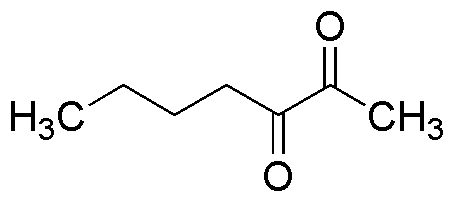2,3-Heptanedione is widely utilized in research focused on:
- Flavoring and Fragrance Industry: This compound is often used as a flavoring agent in food products and as a scent in perfumes, providing a pleasant aroma and taste that enhances consumer appeal.
- Pharmaceuticals: It serves as an intermediate in the synthesis of various pharmaceuticals, contributing to the development of new medications and improving existing formulations.
- Chemical Synthesis: 2,3-Heptanedione is employed in organic synthesis as a building block for creating more complex molecules, making it valuable in research and development labs.
- Analytical Chemistry: This compound is used in analytical methods for detecting and quantifying other substances, aiding researchers in quality control and product development.
- Polymer Industry: It acts as a plasticizer in polymer formulations, enhancing flexibility and durability, which is crucial for producing high-performance materials.
General Information
Properties
Safety and Regulations
Applications
2,3-Heptanedione is widely utilized in research focused on:
- Flavoring and Fragrance Industry: This compound is often used as a flavoring agent in food products and as a scent in perfumes, providing a pleasant aroma and taste that enhances consumer appeal.
- Pharmaceuticals: It serves as an intermediate in the synthesis of various pharmaceuticals, contributing to the development of new medications and improving existing formulations.
- Chemical Synthesis: 2,3-Heptanedione is employed in organic synthesis as a building block for creating more complex molecules, making it valuable in research and development labs.
- Analytical Chemistry: This compound is used in analytical methods for detecting and quantifying other substances, aiding researchers in quality control and product development.
- Polymer Industry: It acts as a plasticizer in polymer formulations, enhancing flexibility and durability, which is crucial for producing high-performance materials.
Documents
Safety Data Sheets (SDS)
The SDS provides comprehensive safety information on handling, storage, and disposal of the product.
Product Specification (PS)
The PS provides a comprehensive breakdown of the product’s properties, including chemical composition, physical state, purity, and storage requirements. It also details acceptable quality ranges and the product's intended applications.
Certificates of Analysis (COA)
Search for Certificates of Analysis (COA) by entering the products Lot Number. Lot and Batch Numbers can be found on a product’s label following the words ‘Lot’ or ‘Batch’.
*Catalog Number
*Lot Number
Certificates Of Origin (COO)
This COO confirms the country where the product was manufactured, and also details the materials and components used in it and whether it is derived from natural, synthetic, or other specific sources. This certificate may be required for customs, trade, and regulatory compliance.
*Catalog Number
*Lot Number
Safety Data Sheets (SDS)
The SDS provides comprehensive safety information on handling, storage, and disposal of the product.
DownloadProduct Specification (PS)
The PS provides a comprehensive breakdown of the product’s properties, including chemical composition, physical state, purity, and storage requirements. It also details acceptable quality ranges and the product's intended applications.
DownloadCertificates of Analysis (COA)
Search for Certificates of Analysis (COA) by entering the products Lot Number. Lot and Batch Numbers can be found on a product’s label following the words ‘Lot’ or ‘Batch’.
*Catalog Number
*Lot Number
Certificates Of Origin (COO)
This COO confirms the country where the product was manufactured, and also details the materials and components used in it and whether it is derived from natural, synthetic, or other specific sources. This certificate may be required for customs, trade, and regulatory compliance.

